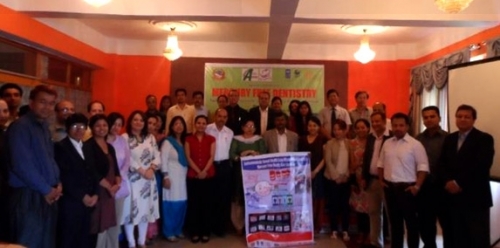National

National Conference on Mercury Free Dentistry, Regulatory Framework, Phase out Plan and Inclusion of Mercury Alternatives in Curriculum was jointly organized by CEPHED and Nepal Dental Association on May 26-27, 2014with the support from UNDP GEF Small Grant Program, World Alliance for Mercury Free Dentistry, Asian Center for Environmental Health and the coordination from Ministry of Health and Population, Government of Nepal, Department of Health Services, Government of Nepal, Management Division, Department of Health Services, Government of Nepal and Oral Health Focal Point, Government of Nepal with the objective to solicit the Sectoral Commitment of Phase out Mercury Amalgam, Regulatory framework and Alternative Dental curriculum and introduce Asian Center dealt with Mercury Issues in South Asia.
Few presentations were made during the program such as:
- From Dr. Shahriar Hossain, Vice President, South Asia, World Alliance Mercury Free Dentistry on 'Mercury Phase out Plan in Dentistry' and Conceptual Framework for alternatives in mercury amalgam.
- From Ms. Siddika Sultan, Director, Asian Center for Environmental Health on 'Introduction of Asian Center and its role on Asia Pacific Region'
- From Mr. Rajesh Ghimire, Senior Environmental Journalist, NEFEJ on 'Media role and its significance on public health related issues'
- From Mr. Ram Charitra Sah presented on 'Health Care Waste Management and Mercury Free Health Care Services'.
- From Mr. Ashok Bhurtyal, WHO on 'Global drive towards reducing exposure to mercury and WHO roles'.
- From Dr. Senchhema Limbu, General Secretary, Nepal Dental Association on 'Walking Towards'. 'Mercury Free Dentistry'
Major 5 point drawn from the group discussion and sectoral commitments made as important point for Kathmandu Declaration for Mercury Free Dentistry which are as follows:
- Comprehensive regulatory frameworks (Acts and Regulation) to promote mercury free health care services and mercury free dentistry in Nepal by 2015/2016
- General Practitioners and Professionals Associations have agreed to stop using mercury amalgam in children and pregnant women by 2017 and phase-out use of mercury amalgam from dentistry by 2018.
- Academic University and Institutions have agreed to revised and fully implement the dental curriculum by 2019.
- Issues of awareness raising, development of waste management facilities and encourage of insurance policy and tax exemption for mercury free alternatives.
- Ratification of the Minamata Convention on Mercury as soon as possible.
Interaction program was organized on 4th Feb 2013 on topic 'MERCURY FREE HEALTH CARE SERVICES, PROBLEM AND PROSPECTIVE IN NEPAL' with support from Ministry of Health and Population (MOHP/GON) and World Alliance for Mercury Free Dentistry (WAMFD) with the objective to discuss about the Health care services related issues concentrating on use of dental amalgam. Major components of the program were as mercury toxicity in health care services, its adverse health effect especially to dentists due to frequent use of dental amalgam and explore the possibility of working together towards the removal of mercury based instruments and mercury or mercury containing compound from hospital premises and shifting into mercury free health care services.
Few presentation were made such as:
- From Dr. Shariar Hossain on 'Global perspective on Mercury Free Health Care Services and Countdown of Mercury based measuring devices and chemicals in Health sector w.r.to upcoming Minamata Convention 2013'
- From Mr. Ram Charitra Sah on 'Mercury and its impacts on Human Health and Environment in Nepal'
Chemical Safety, Networking and Alliance building program was organized on 31st December 2012 with the specific objective to inform about the issue of chemical pollution and need of strong chemical safety guidelines and policies especially in the sector like cosmetic products, imitation jewelries, end-of-life management of mercury containing products like CFL and health related products such as thermometers, Sphygmometer etc.
The general objective of the program was to
- Raise awareness about overall chemical safety.
- Share the result and information obtained from CEPHED's past researches mostly focused on chemicals.
- Initiate the networking and alliance building for robust chemical safety.
- Solicit the key message conveyed to INC5 Geneva through MOSTE and CEPHED.
- Commit for the betterment of public health and environment through high level discussions.
Launching of EU IPEN Lead Paint Elimination Project was organized on 23rd July 2012 with the motive to share the information regarding the conduction of study of paints to be completed during 2012-2015 as part of EU IPEN Switch Asia Lead Paint Elimination Project.
Information regarding the lead, its use, source of exposure and its impact on human health was shared among participants.
Stakeholder interaction program on "LEAD IN PAINT, NOT HERE, NOT ANYWHERE" was organized on November 3rd 2011 with the aim of soliciting the future plan of action to address the lead in paint issues of Nepal. The participants are from the various stakeholders representatives including paint industries, painters, labor union, consumer forum, NGOs, INGOs, GOs, academic institute, scientific institute, federation of industries and commerce, department of commerce and different journalists from several media houses.
National workshop on Health Care Waste Management and Mercury Free Health Care was organized on January 13th-14th 2011 with the coordination and support of Ministry of Health and Population (MOHP), Department of Health Services (DOHS), Management Division at Kathmandu. High level government officials such as ministries and secretaries were part of the program. Information regarding the Health Care Waste Management and Mercury Free Health Care Services were shared among the participants and the IEC materials were disseminated.




